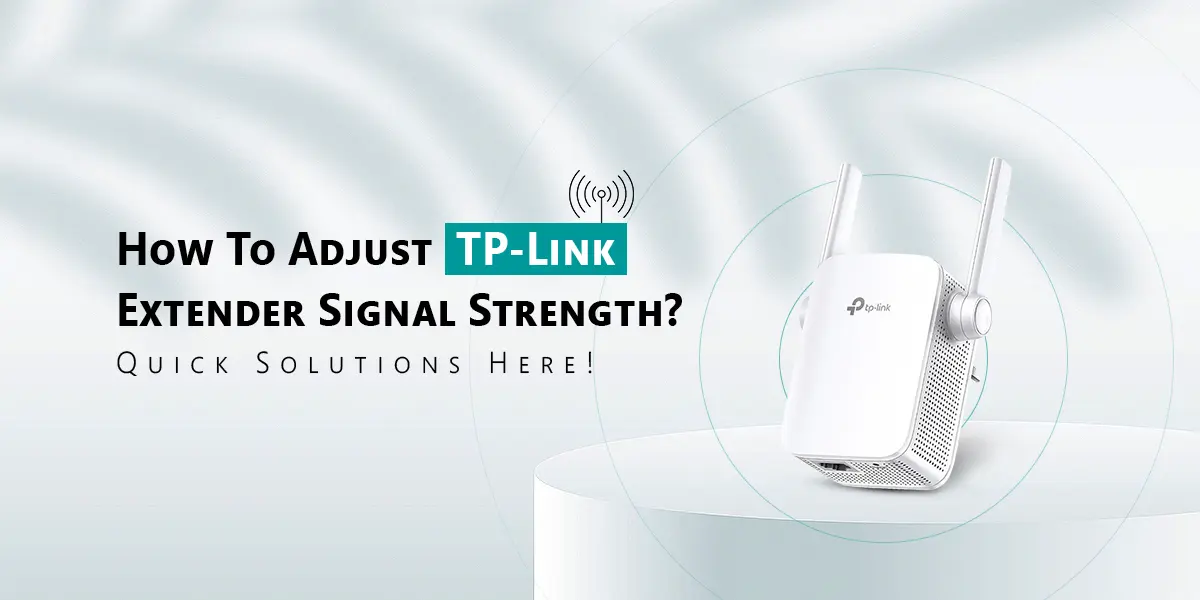
How To Adjust TP-Link Extender Signal Strength? Quick Solutions Here!
An effective tool for improving network coverage is a TP-Link extender especially if you’ve ever experienced poor Wi-Fi signals in specific regions of your house or place of business. However, you may need to modify the signal strength of your TP-Link extender in order to get the most out of it. Changing your TP-Link extender’s signal strength can be essential if you want to increase coverage or decrease interference. We’ll go over simple quick fixes in this blog post for how to Adjust TP-Link Extender Signal Strength so you can get the most out of your Wi-Fi.
Recognizing Your TP-Link Extender
It’s crucial to comprehend what a TP-Link extender accomplishes before making any changes. In essence an extender expands the Wi-Fi coverage area by boosting the signal from your router. Large residences or structures with thick walls that may impede Wi-Fi signals can benefit most from this.
Why to Adjust TP-Link Extender Signal Strength?
- Reduce Interference: Modifying the signal strength can assist reduce interference if you have several Wi-Fi networks or devices.
- Optimal Coverage: Occasionally not all locations may be effectively shielded by the default settings. Better coverage may be ensured by varying the strength.
- Energy Efficiency: Lowering the signal strength can save energy and reduce unnecessary radiation.
- Network Security: Controlling the range can help keep your network secure by limiting how far the signal reaches.
Steps for How To Adjust TP-Link Extender Signal Strength
1. Go to the Settings of the TP-Link Extender
- Link your device to the network of extender.
- Pass in the IP address of extender in browser once it is open. Usually, tplinkrepeater.net or 192.168.0.254 are the addresses.
Pass in your keyword and username to login. Admin is typically the default credential for both arenas.
2. Go to the Wireless Configuration
After logging in do the following actions:
Navigate to the Wireless section on the interface of the extender.
If your extender is dual-band capable you will be able to choose between the 2.4GHz and 5GHz frequencies.
3. Modify the Transmit Power
Look for a setting called Transmit Power or Power Setting under the wireless settings.
Usually there are three options available: High Medium and Low.
Select the configuration that encounters your needs:
High: Covers the maximum area; perfect for rooms with lots of space.
Medium: Ideal for regions of intermediate size it strikes a balance between performance and coverage.
Low: Minimizes interference and conserves energy by shrinking the coverage area.
4. Save and Restart
Save the settings after choosing the transmit power level you want to use. Rebooting the extender is frequently required for changes to take effect. Rebooting should be an option in the settings menu.
5. Optimizing Your Offer's Position
While tweaking the signal strength settings is important where you position your TP-Link extender can have a big effect on how well it works. Here are some pointers:
Central Location: To improve coverage, position the extender midway amongst router and the anticipated exposure area.
- Steer clear of obstacles: Keep it clear of walls big metal objects and potentially interference-causing electrical appliances.
- Elevate: To lessen obstacles, place the extender higher up or on a shelf.
Troubleshooting Typical Problems
It is possible that problems will persist even after you have Adjust TP-Link Extender Signal Strength. Here are some pointers for troubleshooting:
1. Weak Signal Check Location: Make sure the extender is close enough to the router to be useful.
Interference: Adjust the Wi-Fi channel in the extender’s settings to lessen interference.
2. Delay in Motion
Device Load: When an extender has too many devices connected to it speeds may be slowed down. If at all feasible unplug a few electronics.
Firmware Update: Update the firmware on your extender to get the best possible performance.
3. Losses in Connectivity
Stable Power Supply: Verify that the extender cord is allied to a fixed power stock.
Network Congestion: When changing the settings or restarting the extender steer clear of periods of high demand.
Final Thoughts
Your Wi-Fi experience can be significantly improved by easily Adjust TP-Link Extender Signal Strength. Through the extender’s settings you may optimize coverage minimize interference and enhance network efficiency by adjusting the transmit power. For optimal outcomes don’t forget to think about where to put your extender and solve any problems that may come up. You’ll be well on your way to having a stronger and more dependable Wi-Fi connection across your room with these easy fixes.